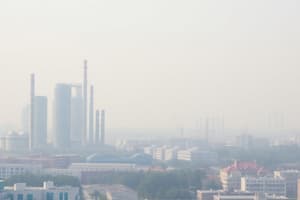Podcast
Questions and Answers
Air Quality is solely determined by the levels of pollutants released by sources.
Air Quality is solely determined by the levels of pollutants released by sources.
False (B)
The Clean Air Act regulates indoor air pollution.
The Clean Air Act regulates indoor air pollution.
False (B)
There are six criteria air pollutants defined by the National Ambient Air Quality Standards.
There are six criteria air pollutants defined by the National Ambient Air Quality Standards.
True (A)
Ozone is a pollutant that is directly emitted into the atmosphere.
Ozone is a pollutant that is directly emitted into the atmosphere.
Point source emissions refer to pollution that is released from large, identifiable sources.
Point source emissions refer to pollution that is released from large, identifiable sources.
The value of a National Ambient Air Quality Standard is independent of the time period over which the measurement is averaged.
The value of a National Ambient Air Quality Standard is independent of the time period over which the measurement is averaged.
Mobile and fugitive emissions are not regulated by the Clean Air Act.
Mobile and fugitive emissions are not regulated by the Clean Air Act.
Changes in meteorology can affect air quality by influencing chemical reactions of pollutants.
Changes in meteorology can affect air quality by influencing chemical reactions of pollutants.
Primary standards of NAAQS focus on protecting human health and the environment.
Primary standards of NAAQS focus on protecting human health and the environment.
Secondary standards of NAAQS are solely concerned with human health.
Secondary standards of NAAQS are solely concerned with human health.
Ambient air quality monitoring is only conducted in rural areas.
Ambient air quality monitoring is only conducted in rural areas.
The CAA requires the EPA to establish criteria for six pollutants.
The CAA requires the EPA to establish criteria for six pollutants.
Carbon monoxide (CO) is one of the five pollutants for which NAAQS are established.
Carbon monoxide (CO) is one of the five pollutants for which NAAQS are established.
Air quality monitoring data must reflect the dynamic nature of air quality variation.
Air quality monitoring data must reflect the dynamic nature of air quality variation.
The primary NAAQS standards are less strict than secondary standards.
The primary NAAQS standards are less strict than secondary standards.
The assessment of air quality can help form the basis for new control programs.
The assessment of air quality can help form the basis for new control programs.
Lead (Pb) was added as a photochemical oxidant indicator in a later version of the act.
Lead (Pb) was added as a photochemical oxidant indicator in a later version of the act.
Mobile monitoring is primarily conducted using fixed platforms such as towers.
Mobile monitoring is primarily conducted using fixed platforms such as towers.
Stationary monitoring provides information only about the highest concentration levels of pollutants.
Stationary monitoring provides information only about the highest concentration levels of pollutants.
The vehicle fleet in Jordan includes a significant proportion of older vehicles produced before 1990.
The vehicle fleet in Jordan includes a significant proportion of older vehicles produced before 1990.
Ozone is recognized as a precursor of volatile organic compounds (VOCs).
Ozone is recognized as a precursor of volatile organic compounds (VOCs).
Mobile monitoring can help determine the dispersion of air pollutants from various sources.
Mobile monitoring can help determine the dispersion of air pollutants from various sources.
Natural and anthropogenic sources both have a relative impact on stationary monitoring results.
Natural and anthropogenic sources both have a relative impact on stationary monitoring results.
High-density areas contribute minimally to ambient air quality issues.
High-density areas contribute minimally to ambient air quality issues.
Flashcards
What is Air Quality?
What is Air Quality?
Air quality is a dynamic and constantly changing condition affected by various factors like pollution levels and weather patterns.
What factors affect air quality?
What factors affect air quality?
Air quality is influenced by the amount of pollutants released into the atmosphere and how they interact with the surrounding environment.
What does the Clean Air Act (CAA) regulate?
What does the Clean Air Act (CAA) regulate?
The Clean Air Act (CAA) regulates air pollution released outdoors, specifically emissions from sources like industrial stacks, chimneys, and vehicles.
What are National Ambient Air Quality Standards (NAAQS)?
What are National Ambient Air Quality Standards (NAAQS)?
Signup and view all the flashcards
How is ozone formed?
How is ozone formed?
Signup and view all the flashcards
How do we control ozone levels?
How do we control ozone levels?
Signup and view all the flashcards
How does the time period influence air quality standards?
How does the time period influence air quality standards?
Signup and view all the flashcards
What is not regulated by the Clean Air Act (CAA)?
What is not regulated by the Clean Air Act (CAA)?
Signup and view all the flashcards
Secondary NAAQS
Secondary NAAQS
Signup and view all the flashcards
Primary NAAQS
Primary NAAQS
Signup and view all the flashcards
NAAQS (National Ambient Air Quality Standards)
NAAQS (National Ambient Air Quality Standards)
Signup and view all the flashcards
Ambient Air Quality Monitoring
Ambient Air Quality Monitoring
Signup and view all the flashcards
Dispersion Models
Dispersion Models
Signup and view all the flashcards
Criteria Pollutants
Criteria Pollutants
Signup and view all the flashcards
The Original Five Criteria Pollutants
The Original Five Criteria Pollutants
Signup and view all the flashcards
Clean Air Act (CAA)
Clean Air Act (CAA)
Signup and view all the flashcards
Stationary Monitoring
Stationary Monitoring
Signup and view all the flashcards
Mobile Monitoring
Mobile Monitoring
Signup and view all the flashcards
Microscale Monitoring
Microscale Monitoring
Signup and view all the flashcards
Middle Scale Monitoring
Middle Scale Monitoring
Signup and view all the flashcards
Neighborhood Scale Monitoring
Neighborhood Scale Monitoring
Signup and view all the flashcards
Urban Scale Monitoring
Urban Scale Monitoring
Signup and view all the flashcards
Regional Scale Monitoring
Regional Scale Monitoring
Signup and view all the flashcards
Air quality monitoring in urban areas
Air quality monitoring in urban areas
Signup and view all the flashcards
Study Notes
Air Pollution: Air Quality & Monitoring
- Air quality is a dynamic and complex environmental phenomenon exhibiting large temporal and spatial variations.
- Temporal and spatial variations in atmospheric pollution levels are caused by changes in pollutant source emission rates and changes in meteorology and topography. These variations influence chemical reactions of pollutants in the atmosphere, affecting their control and removal.
- The EPA defines ambient air as the portion of the atmosphere external to buildings accessible to the public.
- The Clean Air Act (CAA) regulates pollution entering the outside air, including emissions from stacks, chimneys, vents, and equivalent openings (point and area sources).
- The CAA also regulates mobile and fugitive emissions released directly into the atmosphere, but it does not regulate indoor air pollution or pollution contained within private property.
- The EPA establishes National Ambient Air Quality Standards (NAAQS) for every pollutant designated as a "criteria" pollutant.
- Six criteria air pollutants are ozone, particulate matter (PM10 and PM2.5), sulfur oxides, carbon monoxide, nitrogen dioxide, and lead.
- Ozone is not directly emitted but forms through interactions of volatile organic compounds (VOCs) and nitrogen oxides (NOx) in the presence of sunlight.
- NAAQS includes primary (health-based) and secondary standards (public welfare and property protection).
Types of NAAQS
- Primary standards protect human health, focusing on the most sensitive segments of the population (children, elderly, asthmatics).
- Secondary standards protect general public welfare and prevent damage to public property.
- Both primary and secondary standards specify maximum pollutant concentrations in ambient air.
NAAQS (Primary & Secondary)
- This table details specific primary and secondary standards for various pollutants, including average concentrations and time periods over which averages are taken.
Specific pollutant data are provided in the table format (e.g., 8-hour CO average, maximum 24-hour PM10 level). - Values and time periods for measuring the values are listed. (e.g., CO 8-hour average level, PM10 24-hour maximum).
- Primary and secondary standards are either the same or listed as "No secondary standard".
Air Monitoring
- Air quality monitoring is complex, requiring data collection that resolves the dynamic nature of air quality in terms of spatial and temporal variations.
- Ambient air quality monitoring is the systematic and long-term assessment of air pollutant levels in communities.
- Monitoring may be focused on characterizing air quality in urban areas, near large pollution sources or in areas with sensitive environmental receptors (e.g., living things).
- Monitoring quality depends on accurate and representative data, considering existing conditions and dispersion models, to predict future pollution levels.
- Monitoring networks are used to characterize regional and national air quality conditions, assess health impacts, evaluate control program effectiveness, establish new control programs, assess source impacts, and provide public information.
Stationary Monitoring
- A stationary monitoring network provides information on background concentrations, maximum concentration levels, representative concentration levels in areas with high density, impact of local sources, impact of distant sources and the contribution of natural versus anthropogenic sources.
- Scale includes microscale (1-100 m), middle scale (100 m - .5 km), neighborhood scale (.5 - 4 km), urban scale (4-50 km), regional scale (10 - hundreds of km).
Mobile Monitoring
- Mobile monitoring uses movable platforms.
- It's used for atmospheric transport and chemical transformation processes.
- Instrumentation can provide data to understand smog, acidic deposition, and air pollutant dispersion.
- Mobile monitoring can be used to identify and characterize hotspots with high concentrations for specific pollutants. Such areas may be nearby large sources or contain poor meteorological conditions.
- Mobile monitoring is also used for hazardous chemical spills at plants.
Air Quality in Jordan
- Air quality is a problem in Jordan, with high-density areas of vehicular traffic.
- Major sources of pollution in Jordan are vehicles, industries, and residential activities.
- The vehicle fleet includes many older models (pre-1990) which contribute significantly to emissions.
- Industrial sources include cement plants, power plants, and phosphate/potash industries.
- Specific data are provided for sources and their pollution contribution levels for different pollutants. (Amounts, and percentages are listed for pollutants released by transportation vehicles, industry, electricity production).
Additional Information
- Tables detail specific air pollutant sources, monitoring sites, pollutants monitored, and monitoring frequencies,
Studying That Suits You
Use AI to generate personalized quizzes and flashcards to suit your learning preferences.




